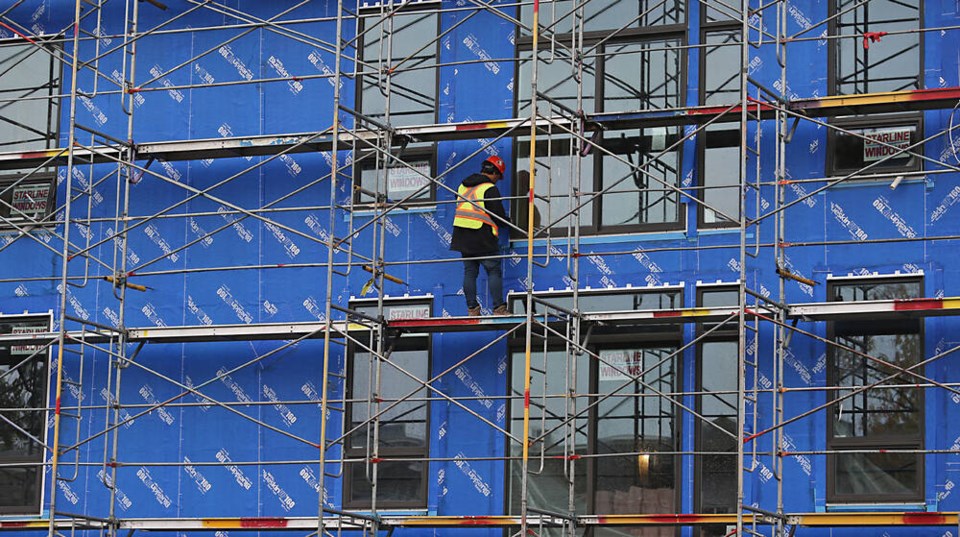Victoria’s unemployment rate improved to 4.3 per cent in October, driven by a booming construction industry that has been somewhat immune, so far, to the prevailing economic headwinds and ongoing labour shortage.
According to numbers released Friday by Statistics Canada, Victoria’s labour force increased by 4.8 per cent to 225,600 between October of this year and last, while the number of people employed here increased 5.2 per cent to 216,000.
The biggest increase year over year was in the construction industry, which saw its total employment increase to 19,600 in October from 12,700 at the same time last year.
The wholesale and retail trade sector also saw a significant improvement with 3,700 more positions in October compared with last year, while the transport and warehousing sector saw an increase of 2,600 jobs.
The business, building and support services sector, which covers contracted administration and human resources services as well as cleaning services, saw the biggest decrease year-over-year, shedding 5,100 positions, while educational services dropped 1,900 jobs over the last 12 months.
“It’s not surprising the numbers in construction are high,” said Chris Atchison, president of the B.C. Construction Association, who added the numbers have increased over the last three years. “There’s been steady growth in construction both in terms of activity and attraction to the workforce.”
He said the construction labour force in the province now numbers about 236,000, ranking it the number-one employer in the goods-producing sector.
Atchison said the growth comes down to demand. “Home building, industrial and institutional builds have been part of what’s carried our economy throughout the pandemic.”
With rising interest rates and high supply and labour costs, however, the private sector has started to pull back on spending, though public investment in institutional projects remains fairly steady and the labour shortage is still the industry’s biggest problem.
Atchison said while they are still riding a wave of investments that have already been made in big projects, there are challenging times ahead.
He also noted that while the Statistics Canada numbers show an overall increase, the number of skilled trades continues to drop. The B.C. Construction Association reports there are now 171,000 skilled workers in the sector, a drop of about five per cent over the last three years.
Rory Kulmala, chief executive of the Vancouver Island Construction Association, said the province will be short 27,000 to 30,000 skilled trades workers by 2027, which on the Island could translate into a shortage of 10,000 to 15,000 in the next five years.
“The demand for [skilled trades] is still there notwithstanding the reports that we’re heading for a recession,” he said.
Kulmala agrees with Atchison that construction spending could tighten up as a result of increased interest rates, but says there is still heavy demand for new housing.
Casey Edge, executive director of the Victoria Residential Builders Association, said his membership remains busy, but continues to struggle with a tight labour market and supply issues.
He said mortgage costs and the stress test for new home buyers will get tougher with higher interest rates, which will make new development more challenging.
“But builders are a very resilient group — it is an industry with ebb and flow and to be successful in this business, you really have to know how to adapt to varying economic conditions,” he said.
Across Canada, the labour market showed signs of life in October with a surprise jump in the number of jobs, but economists still expect to see the economy slow more noticeably in the coming months.
According to Statistics Canada, the country added 108,000 jobs in October and the unemployment rate held steady at 5.2 per cent as more Canadians looked for work.
The October job gains come after four months of losses or little growth.
It’s also at odds with bubbling fears that the Canadian economy is headed for a possible recession as interest rates rise.
“This jobs report checked all the boxes in terms of being a blowout report,” TD economist Rishi Sondhi said in a client note. “The Canadian labour market clearly still has some steam left to it.”
Desjardins chief economist Jimmy Jean said although the report beat expectations by a significant amount, the economy is still expected to slow considerably in response to higher rates.
“What we know from history is that when that happens, you see a slowdown in consumer spending, in housing as well,” Jean said. “And that tends to lead to [an overall economic] slowdown.”
However, Jean said that slowdown doesn’t necessarily have to be severe or long-lasting.
The Bank of Canada has been raising interest rates aggressively this year in response to decades-high inflation. It’s signalled it plans to raise rates further, though the end of the rate-hiking cycle appears to be near.
Desjardins forecasts the central bank will opt for a quarter-percentage point rate hike in December, the smallest increase since March 2, though Jean said he’s planning to wait for new economic data to assess whether that forecast needs to change.
Ravi Kahlon, B.C.’s Minister of Jobs, noted the province added nearly 10,000 new jobs in the month of October and boasted an unemployment rate of 4.2 per cent.
— With afile from The Canadian Press



